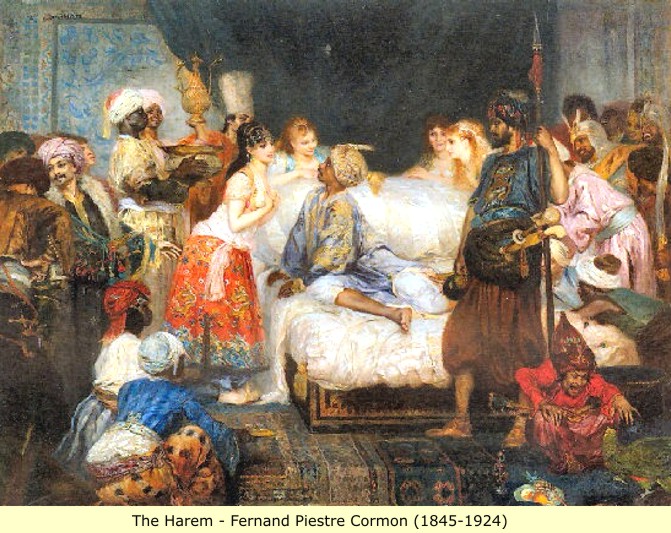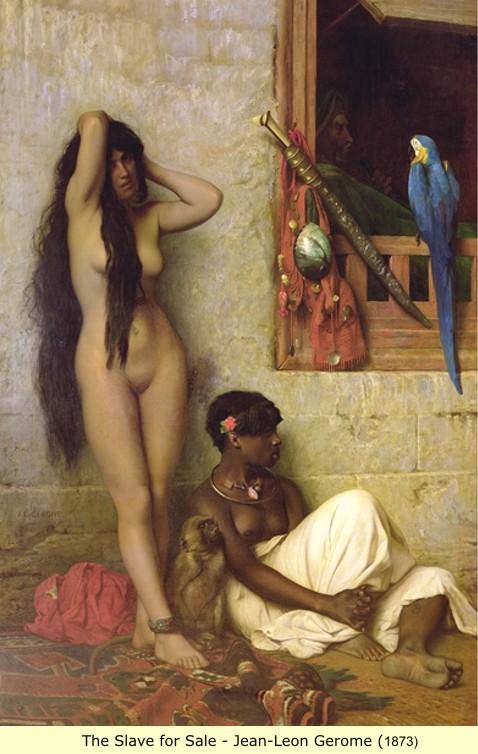Contrary to conventional thought, Slavery was NOT only endured by Blacks, all peoples have at one time or another been enslaved. The irony is that it is Blacks who appear to have created the institution of Slavery. As the creators of civilization, and the builders of the worlds first cities, Blacks logically were the first to have a need for slaves, as a source of free labor. Slavery in ancient cultures was known to occur in civilizations as old as Sumer, and it was found in every civilization, including Ancient Egypt, the Akkadian Empire, Assyria, Ancient Greece, Rome and parts of its empire.

The Islamic World was also a main factor in Medieval European slavery. From the early 700s until the early Modern time period (rough the 18th or 19th centuries) Arabs and Berbers (Moors) consistently took European slaves. This slavery began during the Muslim Conquest of Visigothic Spain and Portugal in the 8th century. The Muslim powers of Iberia both raided for slaves and purchased slaves from European merchants; the Jewish Radhanites, one of the few groups that could easily move between the Christian and Islamic worlds.

Such institutions were a mixture of debt-slavery, punishment for crime, the enslavement of prisoners of war, child abandonment, and the birth of slave children to slaves. In the Roman Empire, probably over 25% of the empire's population, and 30 to 40% of the population of Italy was enslaved. Records of slavery in Ancient Greece go as far back as Mycenaean Greece. It is often said that the Greeks as well as philosophers such as Aristotle accepted the theory of natural slavery i.e. that some men are slaves by nature. At the time of Plato and Socrates, slavery was so accepted by the Greeks (including philosophers) that few people indeed protested it as an institution.
Romans inherited the institution of slavery from the Greeks and the Phoenicians. As the Roman Republic expanded outward, entire populations were enslaved, thus creating an ample supply to work in Rome's farms and households. The people subjected to Roman slavery came from all over Europe and the Mediterranean. Such oppression by an elite minority eventually led to slave revolts (see Roman Servile Wars); the Third Servile War led by Spartacus was the most famous and severe. Greeks, Berbers, Germans, Britons, Thracians, Gauls (or Celts), Jews, Arabs, and many more were slaves used not only for labor, but also for amusement (e.g. gladiators and sex slaves). If a slave ran away, he was liable to be crucified. By the late Republican era, slavery had become a vital economic pillar in the wealth of Rome.
In the Viking era starting c. 793, the Norse raiders often captured and enslaved militarily weaker peoples they encountered. In the Nordic countries the slaves were called thralls. The thralls were mostly from Western Europe, among them many Franks, Anglo-Saxons, and Celts. Many Irish slaves participated in the colonization of Iceland. There is evidence of German, Baltic, Slavic and Latin slaves as well. The slave trade was one of the pillars of Norse commerce during the 6th through 11th centuries. The Persian traveler Ibn Rustah described how Swedish Vikings, the Varangians or Rus, terrorized and enslaved the Slavs, (thus the word Slave).
The Vikings raided across Europe, though their slave raids were the most destructive in the British Isles and Eastern Europe. While the Vikings kept some slaves for themselves as servants, known as thralls, most people captured by the Vikings would be sold on the Byzantine or Islamic markets. In the West the targets of Viking slavery were primarily English, Irish, and Scottish, while in the East they were mainly Slavs. The Viking slave trade slowly ended in the 1000s, as the Vikings settled in the European territories they once raided.

The Mongol invasions and conquests in the 13th century made the situation worse. The Mongols enslaved skilled individuals, women and children and marched them to Karakorum or Sarai, whence they were sold throughout Eurasia. Many of these slaves were shipped to the slave market in Novgorod, (near Moscow in Russia).
Slave commerce during the Late Middle Ages was mainly in the hands of Venetian and Genoese merchants and cartels, who were involved in the slave trade with the Golden Horde. In 1382 the Golden Horde under Khan Tokhtamysh sacked Moscow, burning the city and carrying off thousands of inhabitants as slaves. Between 1414 and 1423, some 10,000 eastern European slaves were sold in Venice. Genoese merchants organized the slave trade from the Crimea to Mamluk Egypt. For years the Khanates of Kazan and Astrakhan routinely made raids on Russian principalities for slaves and to plunder towns. Russian chronicles record about 40 raids of Kazan Khans on the Russian territories in the first half of the 16th century. In 1521, the combined forces of Crimean Khan Mehmed Giray and his Kazan allies attacked Moscow and captured thousands of slaves.
In 1441, Haci I Giray declared independence from the Golden Horde and established the Crimean Khanate. For a long time, until the early 18th century, the khanate maintained a massive slave trade with the Ottoman Empire and the Middle East. In a process called the "harvesting of the steppe", they enslaved many Slavic peasants. About 30 major Tatar raids were recorded into Muscovite territories between 1558-1596. In 1571, the Crimean Tatars attacked and sacked Moscow, burning everything but the Kremlin and taking thousands of captives as slaves. In Crimea, about 75% of the population consisted of slaves.
The Islamic World was also a main factor in Medieval European slavery. From the early 700s until the early Modern time period (rough the 18th or 19th centuries) Arabs and Berbers (Moors) consistently took European slaves. This slavery began during the Muslim Conquest of Visigothic Spain and Portugal in the 8th century. The Muslim powers of Iberia both raided for slaves and purchased slaves from European merchants; the Jewish Radhanites, one of the few groups that could easily move between the Christian and Islamic worlds.

As the Muslims failed to conquer Europe in the 8th century they took to pirate raids against the shores of Spain, southern Portugal and France, and Italy, that would last roughly from the 9th century until the 12th century, when the Italian city-states of Genoa, Venice, and Pisa, along with the Spanish kingdoms of Aragon and Castile, as well as the Sicilian Normans, began to dominate the Mediterranean. The Middle Ages from 1100 to 1500 saw a continuation of the European slave trade, as there was a shift from the Western Mediterranean Islamic nations to the Eastern nations, as Venice and Genoa took firm control of the Eastern Mediterranean from the 12th century and the Black Sea from the 13th century sold and both Slavic and Baltic slaves, as well as Georgians, Turks, and other ethnic groups of the Black Sea and Caucasus, to the Muslim nations of the Middle East.
The Barbary Corsairs, sometimes called Corsairs or Barbary Pirates, were Muslim pirates and privateers who operated from North Africa from the time of the Crusades (11th century) until the early 19th century. Based in North African ports such as Tunis, Tripoli, Algiers, Salé, and other ports in Morocco, they sailed mainly along the stretch of northern Africa known as the Barbary Coast. But their predation extended throughout the Mediterranean, south along West Africa's Atlantic seaboard, and into the North Atlantic as far north as Iceland, and they primarily commandeered western European ships in the western Mediterranean Sea. In addition, they engaged in Razzias, raids on European coastal towns to capture Christian slaves to sell at slave markets in places such as Algeria and Morocco.
These Pirates destroyed thousands of French, Spanish, Italian and British ships, and long stretches of coast in Spain and Italy were almost completely abandoned by their inhabitants, discouraging settlement until the 19th century. From the 16th to 19th century, pirates captured an estimated 800,000 to 1.25 million Europeans as slaves, mainly from seaside villages in Italy, Spain, and Portugal, but also from France, Britain, the Netherlands, Ireland and as far away as Iceland and North America. The most famous corsairs were the brothers Hayreddin Barbarossa ("Redbeard") and Oruç Reis, who took control of Algiers in the early 16th century.
The Byzantine-Ottoman wars and the Ottoman wars in Europe brought large numbers of Christian slaves into the Islamic world too. After the battle of Lepanto approximately 12,000 Christian galley slaves were freed from the Ottoman Turks. Christians were also selling Muslim slaves captured in war. The Knights of Malta attacked pirates and Muslim shipping, and their base became a center for slave trading, selling captured North Africans and Turks. Malta remained a slave market until well into the late 18th century. It required a thousand slaves to equip merely the galleys (ships) of the Order.
Slavery in Poland was forbidden in the 15th century; in Lithuania, slavery was formally abolished in 1588; they were replaced by the second enserfment. Slavery remained a minor institution in Russia until the 1723, when the Peter the Great converted the household slaves into house serfs. Russian agricultural slaves were formally converted into serfs earlier in 1679. The runaway Polish and Russian serfs and kholops known as Cossacks (‘outlaws’) formed autonomous communities in the southern steppes.
The sale of European slaves by Europeans slowly ended as the Slavic and Baltic ethnic groups Christianized by the Late Middle Ages. European slaves in the Islamic World would continue into the Modern time period as Muslim pirates, primarily Algerians, with the support of the Ottoman Empire, raided European coasts and shipping from the 16th to the 19th centuries, ending their attacks with the naval decline of the Ottoman Empire in the late 16th and 17th centuries, as well as the European conquest of North Africa throughout the 19th century.
Following the Napoleonic Wars and the Congress of Vienna in 1815 as well as the involvement of the United States Navy in the First and Second Barbary Wars interceding to protect US interests (1801–5, 1815), European powers agreed upon the need to suppress the Barbary pirates and the effectiveness of the corsairs declined. In 1816 a joint Dutch and British Fleet under Viscount Exmouth bombarded Algiers and forced that city and terrified Tunis into giving up over 3,000 prisoners and making fresh promises. Following a resumption of piracy based out of Algiers, in 1824 another British fleet again bombarded Algiers. France colonized much of the Barbary coast in the 19th century
No comments:
Post a Comment